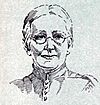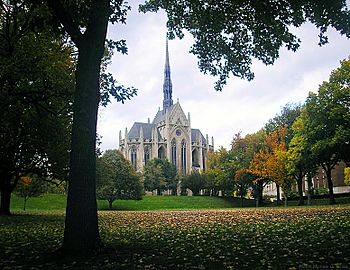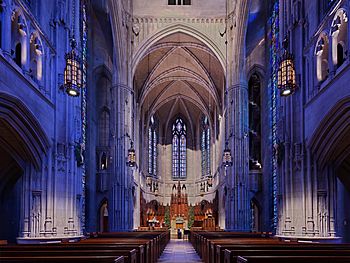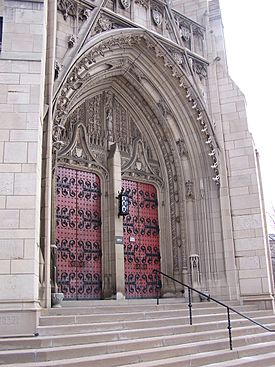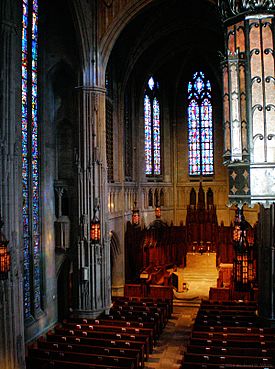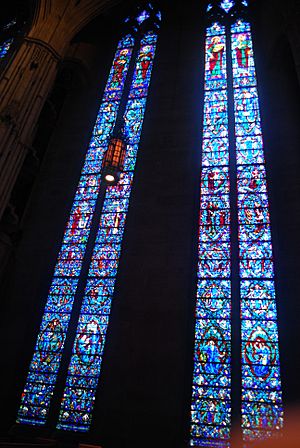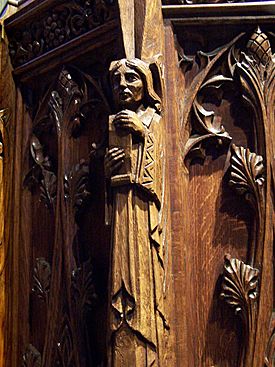Heinz Memorial Chapel facts for kids
|
Heinz Memorial Chapel
|
|
|
U.S. Historic district
Contributing property |
|
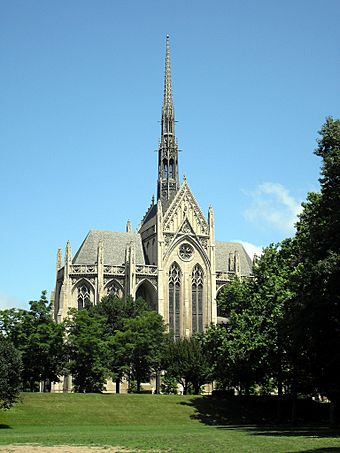
Heinz Chapel at the University of Pittsburgh
|
|
| Location | Intersection of 5th Ave and S Bellefield Ave |
|---|---|
| Nearest city | Pittsburgh, PA |
| Built | 1933–1938 |
| Architect | Charles Klauder |
| Architectural style | French Gothic Revival |
| Part of | Schenley Farms Historic District (ID83002213) |
Quick facts for kids Significant dates |
|
| Added to NRHP | July 22, 1983 |
The Heinz Memorial Chapel is a beautiful building on the campus of the University of Pittsburgh in Pittsburgh, Pennsylvania. It's considered a special historic landmark by the Pittsburgh History and Landmarks Foundation. This chapel is also part of the Schenley Farms National Historic District.
Contents
History of Heinz Chapel
The chapel was a gift from Henry John Heinz, who started the famous H.J. Heinz Company. He wanted to honor his mother, Anna Margaretha Heinz, with a building at the university. After he passed away in 1919, his three children, Howard, Irene, and Clifford, added to his gift. They wanted to remember their grandmother and honor their father. They chose a chapel because Anna Margaretha Heinz believed strongly in education and religion.
Many people worked hard to make the chapel a reality. Howard Heinz, along with Chancellor John Gabbert Bowman and university secretary Joh Weber, were very involved. Other Heinz family members and two important religious leaders, Dr. Hugh Thomson Kerr and Dr. Henry Sloane Coffin, also helped.
Construction began in 1933, and the first stone was laid in 1934. The chapel was officially opened on November 20, 1938. At the dedication, Howard Heinz explained the chapel's meaning: "It is located where my father was born and lived. It is part of a university. As part of that university, it is dedicated to culture, understanding, appreciating beauty, and religious worship."
Chancellor Bowman also shared his thoughts when the cornerstone was laid. He said the chapel was meant to be a special place for worship at the university. He believed it would stand strong and peaceful through time, even as people's spiritual feelings might change.
Since it opened, the Heinz family and their charities, along with other donations, have continued to support the chapel. In 1996, an elevator was added to the north side. This made the chapel fully accessible for people with disabilities. This addition cost $1.25 million and was paid for by the Heinz Endowments and the university.
Important Dates for the Chapel
- January 1914 – Henry John Heinz announced his gift of $100,000 to build a memorial for his mother. He wanted the building to be used for student religious and social activities.
- November 4, 1929 – The Heinz children officially gave the gift to the University of Pittsburgh.
- August 15, 1933 – Construction began on the chapel.
- February 1934 – The cornerstone was placed during a special ceremony.
- June 20, 1934 – Howard Heinz signed a contract to buy a large pipe organ for $24,000. This organ had about 4,295 pipes.
- November 20, 1938 – The chapel was officially dedicated. Dr. Russell G. Wichmann, the first organist, played at the ceremony.
- November 23, 1938 – The first student service was held. It was a Thanksgiving Day service. Many students attended, and some even had to be turned away because it was so full.
- January 11, 1946 – The first wedding ceremony took place in the chapel.
- 1992 – A scene for the movie Lorenzo's Oil was filmed inside Heinz Chapel.
- 1996 – An addition with an elevator was built on the north side of the chapel.
What the Chapel is Used For
Heinz Memorial Chapel is used for many different religious services. It was designed to be open to all faiths, not just one. The chapel is open every day of the year, except for university holidays. About 1,500 events happen there each year, bringing in over 100,000 people. These events include religious services, weddings, concerts, classes, memorial services, and guided tours.
Around 170 to 190 weddings are held in the chapel each year. Only people connected to the University of Pittsburgh or Heinz employees can have their weddings there. The chapel is also home to the Heinz Chapel Choir.
During the school year, the Pittsburgh Compline Choir sings on Sunday evenings. This choir has 20 voices and performs a special evening service.
Chapel Design and Look
Architecture of the Chapel
The chapel was designed in a style called Neo-Gothic. This means it looks like old Gothic churches but was built more recently. The architect was Charles Klauder, who also designed the Cathedral of Learning and the Stephen Foster Memorial. These buildings are right next to the chapel on the Pitt campus. University architect A. A. Klimcheck helped with the design.
Chancellor John G. Bowman and John Weber worked closely with Mr. Klauder. Mr. Weber even traveled to Europe to study church architecture. They wanted the chapel to truly represent what a university chapel should be.
The chapel has a shape like a cross, with stone arches, tall ceilings, and lots of glass. These features were common in American university and church buildings of that time. It is 146 feet (44.5 meters) long and 55 feet (16.8 meters) wide at its widest part. The main hall is 100 feet (30.5 meters) high, and its spire reaches 256 feet (78 meters) into the sky. The walls, both inside and out, are made of Indiana Limestone.
Sadly, Charles Klauder passed away just a few weeks before the chapel was dedicated.
In 1996, a $1.3 million elevator addition was built on the north side. This was done to follow the Americans with Disabilities Act and make the chapel accessible to everyone. The new part was designed to blend in with the rest of the chapel's look.
Beautiful Stonework
The chapel's walls, both inside and out, are made of gray Indiana limestone. The ceiling inside looks like stone but is actually a special ceramic tile that helps with sound. The floor is made of crab orchard stone with green slate in the side aisles. The area around the altar has marble floors, and the altar itself is made of Numidian marble from Egypt.
The stone carvings in the chapel were done by Joseph Gattoni, a master stoneworker from New York. These carvings tell stories, just like in old Gothic churches. They show the chapel's main idea: spiritual values in education. Charles Connick's studio, famous for the stained glass windows, also designed many stone carvings. This includes the Gothic-style shields on the walls and the carving above the main door. This carving shows Jesus with symbols of the Alpha and the Omega, which mean "the beginning and the end."
Carvings on the Outside
The carving above the main entrance, called the tympanum, tells a story. It shows the young Jesus teaching in the Temple, holding a book with the Alpha and Omega symbols. This carving sets the theme for the whole chapel.
To the left of Jesus, there's a small figure of Moses holding the Ten Commandments. Below Moses, you can see medallions with faces of prophets like Isaiah and Jeremiah, and kings like David.
To the right of Jesus, there's a small figure of St. Luke. Below him are medallions with people who represent Jesus's teachings. These include St. Francis of Assisi (for charity), Leonardo da Vinci (for imagination), Isaac Newton (for understanding), and Abraham Lincoln (for leadership).
Outside, shields carved with the symbols of Europe's twelve oldest universities are on the gables. Below them, on the railings, are the seals of American colleges founded before 1820. The seals of colleges founded after 1820 are on the arches below, and women's college seals are on the buttresses.
Seals and Shields Inside
The seal of the University of Pittsburgh from the 1930s is above the main entrance. It is next to the seals of the City of Pittsburgh and the Commonwealth of Pennsylvania. Inside, stone carvings show the Torah and the Bible, the Beatitudes from the New Testament, and shields of the twelve Apostles. These carvings often match the theme of the nearest stained glass window.
Wood and Iron Work
All the visible wood in the chapel is oak. This includes the large entrance doors, which each weigh 800 pounds! The altar screen (reredos), choir seats, railings, pulpit, and lectern are made of English oak. The pews and the ceiling in the entrance area are made of oak from the Appalachian Mountains.
The wood carvings were done by Irving and Casson, A.H. Davenport Company. The four figures carved on the altar screen represent the saints Peter, John, Paul the Apostle, and James the Major.
All the metal work, like the lanterns, door fittings, stair railings, altar cross, and candlesticks, was made by Samuel Yellin from Philadelphia. He also did a lot of metal work in the nearby Cathedral of Learning.
The Amazing Windows
Window Designer
The chapel has 23 stunning stained glass windows. They were designed by a famous artist named Charles Connick and made in his Boston studio. Many people believe these windows are Connick's most important work. They cover about 4,000 square feet (370 square meters) and contain almost 250,000 pieces of glass! You can find 391 different people in the windows, plus many animals and plants.
Connick used to work for the Pittsburgh Press newspaper. He also wrote a book about stained glass. He designed windows for other famous places like St. Patrick's Cathedral and St. John the Divine in New York City. It's special that all the windows in Heinz Memorial Chapel were made by Mr. Connick. This is unusual, as most churches like to have different artists' work. But because all the windows in Heinz Chapel can be seen at once, and because Mr. Connick worked so closely with the chapel planners, he was chosen to design them all.
Colors and Their Meanings
Just like stone carvings use symbols, stained glass uses colors to tell stories and express feelings. Mr. Connick used this "language of color" in Heinz Chapel.
- Red – This warm color shows strong feelings like devotion, divine love, and bravery.
- Blue – This cool color reminds us of the sky. It means divine wisdom, deep thought, and lasting loyalty.
- White – This color represents spiritual success and heavenly treasures.
When colors are combined:
- Gold – This color symbolizes the riches of the earth and abundance.
- Green – This color mixes the wisdom of blue with the richness of gold. It means hope, victory, happiness, and youth.
- Violet – This color combines the wisdom of blue with the love of red. It stands for justice, humility, and royalty.
The main theme of the chapel is charity, shown in the Charity window high above the altar. However, blue is the most common color in the windows. Mr. Connick believed blue was "light itself" and the most beautiful color in stained glass.
Windows in the Altar Area
The five windows in the altar area show virtues like justice, faith, charity, hope, and wisdom. They feature stories about Jesus and people from the Old Testament and New Testament. Smaller windows next to them celebrate music and its role in worship.
Each window's theme is also shown through symbols related to the Tree of Life. For example, the rose symbolizes love in the Charity Window, and the fig tree symbolizes Faith.
Tall Transept Windows
The transept windows are 73 feet (22.3 meters) tall, making them some of the tallest stained glass windows in the world. They represent temperance, truth, tolerance, and courage. These windows are special because they show an equal number of men and women, which was not common when they were made.
Many different people are shown in these windows, from religious figures to people from history, music, science, philosophy, and literature. You can find figures like Beethoven, Bach, Clara Barton, Leonardo da Vinci, Daniel Boone, Charlemagne, Chaucer, Confucius, Emily Dickinson, Keats, Sir Isaac Newton, Napoleon, Ben Franklin, George Washington, Rousseau, Shakespeare, Florence Nightingale, Pocahontas, Pasteur, Edgar Allan Poe, Tennyson, Thoreau, and many more.
Upper Windows
The four upper windows, high above the aisles, show great teachers and thinkers of Christian ideas. The three windows at the west end of the chapel represent three famous Christian books:
- St. Francis of Assisi's Canticle of the Sun – This window shows the "Canticle of the Sun" by St. Francis of Assisi. It has stars, birds, fish, and flames. The main figures are Brother Sun and Sister Moon.
- John Bunyan's Pilgrim's Progress – This central window shows John Bunyan's story of a pilgrim's journey. It starts with sharp shapes at the bottom and ends with the fruit of the Tree of Life at the top. The main figures are Christian and Hopeful.
- The Quest for the Holy Grail from Sir Thomas Malory's Le Morte d'Arthur – This window tells the story of the search for the Holy Grail. Sir Galahad and Sir Percivale's sister are the main figures. It often shows lilies, which mean purity. You can also see lions (courage), unicorns (purity), and serpents (evil).
The Chapel Organ
Original Organ
The chapel's first organ was a large Aeolian-Skinner pipe organ with 3,770 pipes. It was built in Boston starting in 1934. The organ pipes varied greatly in size, from as small as a pencil to large wooden boxes two feet square. The organ's control panel was in a sunken area to the right of the altar. The pipes were hidden behind a gallery and special cloth.
Updated Organ
In the 1960s, the cloth was removed because it was old and affected the organ's sound. The organ needed repairs, so in 1969, a new instrument was installed by the M. P. Moller Company. A smaller control panel was added in the back gallery. This allowed for duets or if the main organ needed service.
The new Moller organ was dedicated on March 21, 1971. It had about 3,954 pipes and 82 stops (unique sounds). The Heinz Endowments paid for this new organ. In 1989, the organ was improved with three electronic 32-foot ranks by the Allen Organ Company. This allowed the organ to make very deep, rich bass sounds. This was one of the first times electronic sounds were used to improve an existing pipe organ.
Current Organ
By the early 1990s, the Moller organ was becoming unreliable. Major work was needed, which happened at the same time the chapel was made accessible for people with disabilities in 1994. The Reuter Organ Company was hired to do this work.
The renovated Reuter organ was dedicated with a concert on September 24, 1995. This organ uses existing parts in a way that is good for the environment and sounds great. The main control panel has three keyboards and a pedalboard. These control all 4,272 pipes and three electronic 32-foot pedal stops. For concerts, this control panel can be moved to the front of the altar area so the audience can see it.
A second control panel is in the back gallery. It controls pipes located in alcoves near the gallery. The main control panel can also access these pipes. Most of the main organ pipes are around the front altar, but a powerful "tuba" (trumpet) stop is located 90 feet (27.4 meters) above in a ceiling chamber.
A full history of the organ is available in a guide prepared in 2003 by Jon J. Danzak. Copies of this guide and two CDs are at the Music Library of the University of Pittsburgh. Dr. Robert S. Lord, who was the university organist for over 40 years, placed them there.


